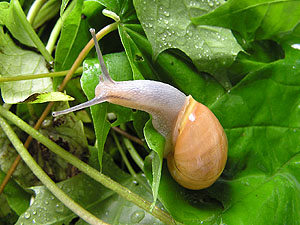
Banded snail (Cepaea hortensis), though without bands… [RN]
 Banded snail (Cepaea hortensis), though without bands… [RN] |
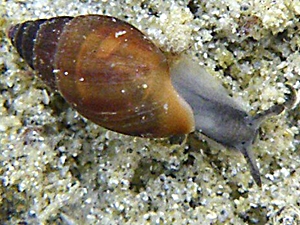 Mouse ear snail (Myosotella myosotis) from Brittany. Picture: Florence Gully, Nature 22: Gastéropodes 2. |
At different times during the evolution of snails (Gastropoda), some members of otherwise marine snail groups independently adapted to life on land. This sometimes took place passing fresh water habitats, such as rivers and lakes), and sometimes the direct way passing the coastal habitats, that share characters of sea and land.
One group of terrestrial snails has remained in this early state of evolution until today - the Ellobiidae. Those ancient snails still live in transient habitats near the sea.
The Midas ear (Ellobium aurismidae) for example, inhabits mangrove swamps in South-East Asia. It combines ancient characters with progressive ones, already pointing towards more modern groups of terrestrial snails.
The mouse ear snail (Myosotella myosotis) is a native member of the Ellobiidae. It lives on salt marshes near the coast of North Sea and Baltic Sea. There it has well adapted to the high degrees of salinity near the North Sea (Myosotella myosotis is able to endure salinity levels of up to 9.9%), as well as the low salinity levels in brackish water river estuaries along the Baltic Sea coast.
|
|
Weichtier des Jahres 2008: Mäuseöhrchen, Mysotella myosotis (Draparnaud 1801) (A brochure about the mollusc of the year 2008, the mouse ear snail, in German). |
The nearest European relatives of the mouse ear snail are the terrestrial thorn snails (Carychiidae), such as the tiny herald thorn snail (Carychium minimum, with a shell length up to 2 mm) living in constantly wet biotopes, mostly near water.
The different evolutionary origins of terrestrial snails make their systematic biology a rather difficult subject. According to different characters, terrestrial snails can be divided into two different groups: the pulmonate snails (Pulmonata), i.e. snails breathing with lungs, and close relatives of prosobranch sea snails (Prosobranchia), originally breathing with gills.
Following the recent development of scientific knowledge on gastropod systematics, especially the discovery of formerly unknown deep sea gastropod groups during the 1970s, the Prosobranchia group has been divided into several independent subgroups, some of which are more closely related to outside groups than other prosobranch groups. So the former common character, the pulmonary cavity in front of the visceral hump, is only a common, but not an exclusive, character of those groups.
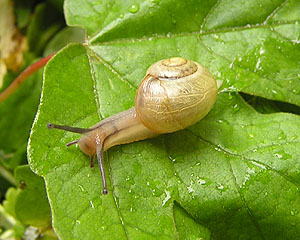 Mainly in juvenile snails, the lung and other organs can easily be seen through the translucent shell wall. [RN] |
So today several independent groups of prosobranch snails are placed opposing the pulmonate snails (Pulmonata) and also the opisthobranch gastropods (Opisthobranchia), whose gills are placed in the rear part of the body.
The antiquated tripartition into Pulmonata, Prosobranchia and Opisthobranchia, however, is still found in many text books.
Their great adaptability has made terrestrial snails one of the most successful animal groups on the earth: Falkner (1990) states a number of around 25,000 species worldwide. Numerous special adaptations have made this possible for snails, to which the dry land as a matter of fact is really dry. Consequently, most adaptations mainly help in saving water and in breathing dry air. Further developments, for example, helped adapt the sense organs, reproduction and development.
The original breathing organ of snails is the comb gill (Ctenidium). As this type of gill is only able to acquire oxygen from water, all terrestrial and numerous fresh water snail species have reduced it. Oxygen from dry air now had to be acquired directly trough the tissues of the pallial cavity wall. Among the pulmonate gastropods (Pulmonata) a network of blood vessels there makes an efficient means of oxygen acquisition.
height="255">
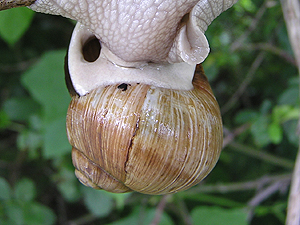 Mantle and respiratory hole are well visible in this Roman snail (Helix pomatia). [RN] |
The loss of water by exhaling to snails presents a major danger which has to be dealt with by several adaptations. As the mantle, apart from generally protecting the body, now additionally has the task of protecting it against evaporation, it grows to an especially thick tissue fold in terrestrial snails. The flow of air into the mantle cavity now passes through the respiratory hole (pneumostome). To open or close it, the snail can use a ring muscle and thus control the flow of air and the loss of water.
A snail's slime additionally protects it against evaporation. It is hygroscopic, which means, that it attracts water rather than releasing it. So even millions of years after their ancestors left the sea, terrestrial snails still wear a coat of water around them.
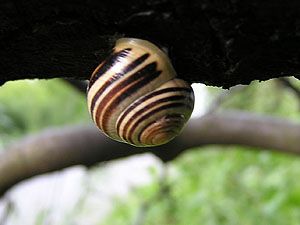 White lipped banded snail (Cepaea hortensis) aestivating on a tree. [RN] |
A further adaptation to dryness can be found in snails' behaviour. If the weather becomes to dry, they will look for a suitable hiding place to endure such times – to aestivate.
To do so, some snail species will dig into the ground (for example, the Corsican snail, Tyrrhenaria ceratina, a relative of the Roman snail, is especially fast in doing so). Others will crawl up plant stems and remain there. To aestivate, they close the shell mouth with a dried mucus membrane, which also sticks them to their place.
Small snails, like the door snails with their spindle-like forms of shells, and also larger ones, whose shell form allows them to do so – such as the lapidary snail (Helicigona lapicida) will hide in crevices of tree bark, rocks and walls. Door snails (Clausiliidae) are especially common on the Balkan Peninsula. And as their name indicates, they are further protected by a special closing apparatus.
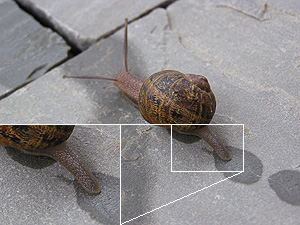 "Jumping" Cornu aspersum (see text). [RN] |
Another part of snail life, which had to adapt to life on dry land, is locomotion. When a snail crawls over the ground, it loses water over the foot sole. So terrestrial snails are able to move by crawling only on parts of their foot sole, thus minimizing the loss of water there. This type of locomotion is called "jumping", as the snail's slime trail leaves a broken trace, as can be seen in the picture on the right.
Terrestrial snails' shells rarely are as resistant as those of their marine counterparts. But they still remain their best and most important protection against dryness and their many enemies. Snail eating thrushes still have to crack their prey's shells open on a suitable stone to get to the interior.
In contrary to their prosobranch relatives, pulmonate snails are exclusively hermaphrodites. Together with losing the shell lid (operculum) this is a character pulmonate snails have in common with the opisthobranch gastropods (Opisthobranchia). Both evolved from common ancestors, only later their evolution went separate ways.
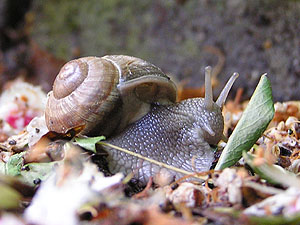 Because it has four tentacles instead of two, this Roman snail (Helix pomatia) has a much larger field of vision to better ob- serve its environment. [RN] |
To be a hermaphrodite doubles an animal's chance of reproduction in regions and times with a low density of individuals. In contrary to marine snails' development passing different larval stages as part of the plankton, the development of terrestrial snails takes place almost exclusively within the egg. In the end, complete young snails hatch, resembling the adults of their kind in the most important characters.
![]() Reproduction of
the Roman snail (Including a
description of the
genital apparatus).
Reproduction of
the Roman snail (Including a
description of the
genital apparatus).
Other than among water-living snails, most terrestrial snails' field of vision is strongly enhanced by placing the eyes on top of special eye stalks, which make a second pair of tentacles. All four tentacles can be withdrawn to protect those important sensors. Observing a snail touching something with its tentacles, one can easily see how fast they can be withdrawn inside the head. The terrestrial group of pulmonate snails, which is also the richest in species of all snails, is consequently called stalk-eye snails (Stylommatophora).
The lips below the tentacles mainly provide the snail with chemical information on the ground it is currently crawling over. Some carnivorous snails, such as the rosy wolf snail (Euglandina rosea) find their prey, other terrestrial snails, by following their slime trail. They consequently have very large lips, almost appearing to be a third pair of tentacles.
Pursuing its prey, a wolf snail also will sometimes crawl under water. But not only carnivorous snails, also some terrestrial slugs, such as the Arion genus, may crawl under water unharmed, for example to eat the water plants in a garden pond.
On the other hand, the terrestrial members of different prosobranch groups can clearly be distinguished from the Stylommatophora. A round-mouthed snail (Pomatias elegans), for example, only has one pair of tentacles at its disposition, its eyes are placed at the base of those tentacles, which also cannot be withdrawn.
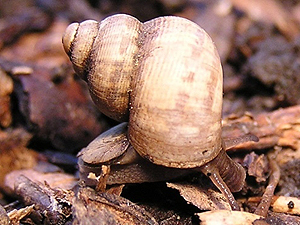 Round-mouthed snail (Pomatias elegans), with a visible shell lid (operculum). Picture: Michael Stemmer. |
At its foot's end (its tail, so to speak) the round-mouthed snail also wears an operculum to close the shell mouth, which is typical for a prosobranch snail.
A round-mouthed snail's head extends to form a snout (proboscis). The mantle cavity is not closed like that of a pulmonate, so this snail does not possess a clearly visible respiratory hole.
![]() Dietrich Meyer:
Sole view of Pomatias elegans through a glass plate.
Dietrich Meyer:
Sole view of Pomatias elegans through a glass plate.
Compared to terrestrial pulmonate snails, the number of species in terrestrial prosobranch snails is much smaller, many of them living in the humid tropics, in the temperate zone under vegetation, or even underground.
There are, though, three groups of terrestrial operculate snails in Europe. Those are the round mouthed snails (Pomatiidae), the needle snails (Aciculidae) and the Cochlostomas (Cochlostomatidae). Of the latter, there is no species present on the British Isles (Anderson, R., 2008 - PDF).
Among terrestrial snails, like among opisthobranchs (such as the nudibranch sea slugs) there is a tendency towards shell reduction, especially as an adaptation to subterraneous or carnivorous way of life.
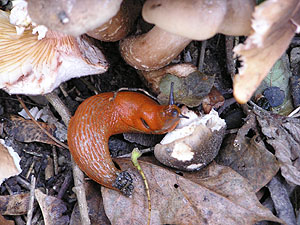 Arion slugs basically are omnivores; they eat mushrooms and carrion, as well as plant matter. [RN] |
Apart from slugs, which have no external shell left (like Arion and Limax slugs), there are also different grades of shell reduction among so called semi-slugs (generally also referred to as slugs, just like the complete kind), but also among glass snails (Vitrinidae) and true glass snails (Zonitidae). Those groups still do have a shell, but it is glassy and translucent, hence the groups' name. A larger extent of shell reduction can be seen in carnivorous semi-slug families, such as Testacellidae and Daudebardias (Daudebardiinae).
Other than in the sea, habitats on land tend to change within relatively small distances. As a consequence, species change in smaller areas, because they are isolated by ecological specialisation and so new species evolve by speciation.
As they necessarily have to camouflage to hide from predators, terrestrial snails, at least in Europe, are usually not as colourful as their marine relatives. However, collections of snail shells have a large importance for the understanding of a biotope's composition. And in the tropics, snail species can be found in all colours of the rainbow, hard to imagine, seeing the rather bleak colours of those snails we know.
Shell characters usually at least roughly allow the determination of a snail's species. A more accurate identification sometimes makes necessary a scientific anatomical examination of the snail's body by a specialist. Especially the characters of its genital apparatus are helpful for determination purposes, as this part of the body is different between even the most closely related snail species.
Outside in the country, a determination key of externally visible shell and body characters (the latter especially for slugs) may be helpful for an approximate determination of terrestrial snails. Shell characters to examine may be colour, pattern, form and dimensions of the shell.
This may, however, become rather difficult looking at a snail species such as Merdigera obscura (the genus name fittingly meaning "excrement-bearer"), which hides under a camouflage from dirt and excrement, so it usually is only recognisable as a snail to a person who knows what to look for.